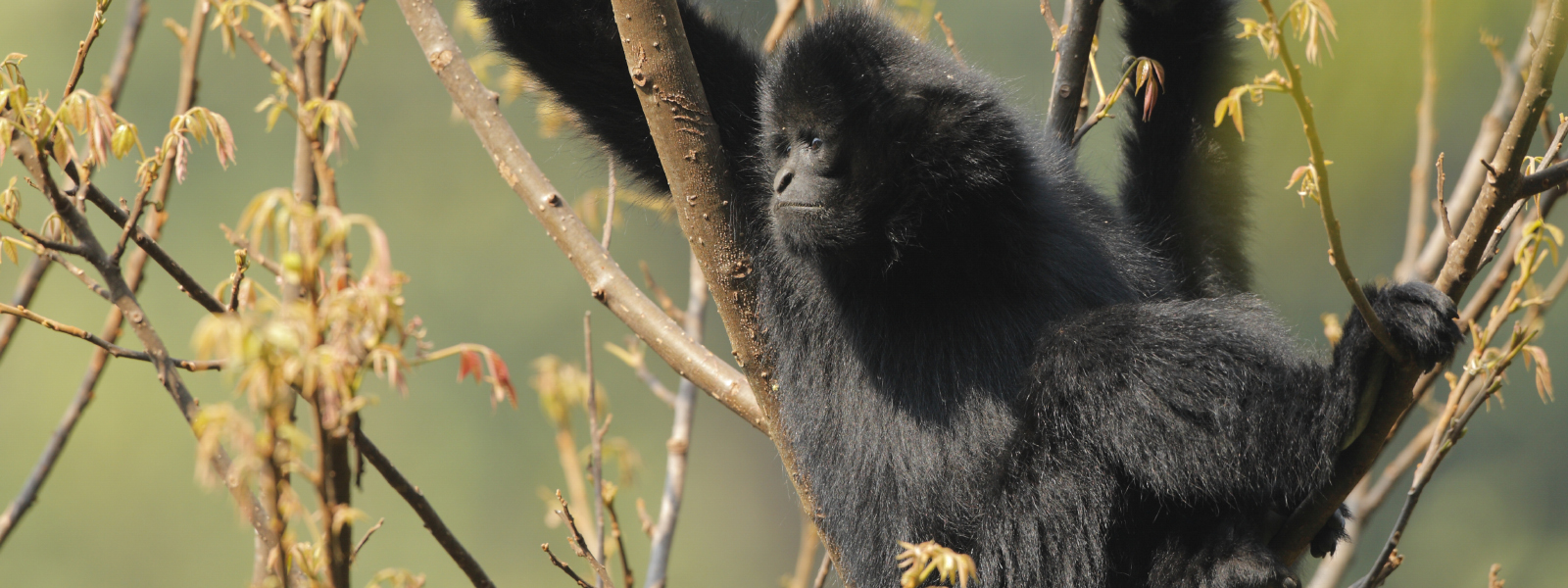Conservation Actions
This species is listed in CITES Appendix I. It is legally protected in Viet Nam (Appendix 1B of Decree 32, 2006) and in Lao PDR (‘Prohibition’ category in the list of protected species) and in China as a Class I Protected Animal under the Chinese Wildlife Conservation Law.In China, about three-quarters of the Wuliang Mountain population's range is protected, much of it within the Wuliang Mountain Nature Reserve and Ailao Mountain Nature Reserve; the species occurs as well in Huanglianshan Nature Reserve, Fenshuilin Nature Reserve, Daxueshan Nature Reserve, Nanguanhe Nature Reserve, Lancangjiang Nature Reserve (Geissmann et al. 2000; Fan 2017).
The Vietnamese population in Mu Cang Chai SHCA/Muong La has been under conservation management by Fauna & Flora International since the late 1990s, with some success. While the population has undergone some sporadic declines since that time, other unprotected areas (notably Van Ban NR) have undergone precipitous declines when protections have been removed (Rawson et al. 2011). These sites are protected by local conservation teams and a co-management mechanism has been put into place to allow local communities to work with protected area authorities, in order to mitigate impacts to wildlife and forests (Rawson et al. 2011).
In Lao PDR, Nam Kan NPA is identified as the only remaining population warranting conservation intervention. This population is partially protected by an ecotourism project, the Gibbon Experience, which funds forest patrols and provides revenue to local communities, reducing risks to the resident population (MAF 2011).
Action Plan
The Conservation Status of Gibbon in Viet Nam 2011
Gibbon Conservation Action Plan for Lao PDR 2011-2020
Location Information
The species as a whole occurs discontinuously in southwestern China, northwestern Lao PDR and northern Viet Nam (Geissmann et al. 2000). One thousand years ago, gibbons that may have been crested gibbons (genus Nomascus) were distributed over a large part of southern and central China up to the Yellow River (Geissmann 1995, Luo 2011, Zhou et al. 2008).Nomascus concolor concolor
This subspecies occurs in southern China (central and southwestern Yunnan) and northern Viet Nam (Lao Cai, Yen Bai, Son La, and Lai Chau provinces) (Geissmann et al. 2000). It is found between the Salween (Nujiang) and Song Hong (Red) Rivers, north to 23°45'N and south to about 20°N (Groves 2001).
Nomascus concolor lu
This subspecies occurs in northwestern Lao PDR. An isolated population, it is known for certain only in a tiny area in on the east bank of the Mekong at about 20°17'-20°25'N (Groves 2001). It is confirmed in Nam Ha NPA, Luang Namtha province, and in the Nam Kan NPA, Bokeo province (Timmins and Duckworth 2013).
Geographic Range
Extant
China, Lao People's Democratic Republic, Viet Nam
Population Information
While the species occurs in Lao PDR, Viet Nam and China, it is China that holds the most significant population of the taxon, with only small populations in the other two countries. Population estimates for the Chinese portion of this species range from about 270 to 300 groups with the most important subpopulations in China residing in the Wuliang and Ailao Mountains (Bleisch and Chen 1991; Peng-Fei et al. 2009; Jiang et al. 2006). Ninety eight groups were reported in the Wuliang Mountains (Haimoff et al. 1986; Jiang et al. 2006; Lan 1993), but a later survey just confirmed 87 groups (Luo 2011). A small population with about four groups was found in Jinggu County recently (H. Bei pers. comm). Most groups found in the Wuliang Mountains live in stable bi-female groups with an average group size of 6.2 individuals (Fan et al. 2006), therefore, the total population in the Wuliang Mountains is estimated to be 500-600 individuals (if an average group size of six individuals is used). In the Ailao Mountains, approximately 180 groups persist in six counties with 124 groups in Xinping, 11 groups in Chuxiong, 2 groups in Nanhua, 26 groups in Shuangbai, 9 groups in Jingdong, and 9 groups in Zhenyuan (Sun et al. 2012); with around 680-720 individuals (if an average group size of four individuals per group is used). In southern Yunnan there are possibly three areas where this species occurs, in Bajiaohe, Jingping County (two groups recorded), Fenshuiling Nature Reserve (possibly 1-2 groups, but not confirmed), and Huanglianshan Nature Reserve (possibly 1-3 groups, but not confirmed (Ni and Ma 2006). The total population in southern Yunnan was estimated to less than 25 individuals (Ni and Ma 2006). On the west bank of Mekong River, there are two sites with confirmed records; three groups in Yongde Daxueshan Nature Reserve (Sun et al. 2012) and two groups in Xuezhulingdashan. This population, formerly recognized as Nomascus concolor furvogaster, is on the edge of extinction.The population of N. c. concolor in Viet Nam consists of only 22–25 groups, with ca. 20 groups in the contiguous Mu Cang Chai Species Habitat Conservation Area, Yen Bai Province and Muong La forests, Son La Province and only 2–5 groups in Van Ban Nature Reserve (Haimoff et al. 1986; Rawson et al. 2011; Tien 1983). In Van Nan, the population is likely decreasing and in Muong La/Mu Cang Chai it has stabilized in recent years (Rawson et al. 2011).
The population of N. c. lu in Lao PDR is, likewise, heavily suppressed and is known to occur in only two areas: Nam Kan NPA and Nam Ha NPA (MAF 2011). In Nam Kan NPA, in the most recent and comprehensive surveys, only three localities were found to still hold gibbons, with 10 gibbon groups heard and 39 individuals observed. This suggests that the largest Lao PDR population is small and vulnerable; the study documented some locations previously known to have gibbons no longer did. The core population is centred around an ecotourism project which, together with local taboos against hunting, provides protection for this small population (Youanechuexian et al. 2014).
Threats
The biggest threats to Nomascus concolor throughout its range include destructive local forest use and hunting while selective logging and agriculture encroachment are additional threats (Geissmann et al. 2000; Jiang et al. 2006; Sun et al. 2012; Wei et al. 2017). In Lao PDR, despite the presence of local taboos on hunting gibbons in some area (Geissmann 2007; Rawson et al. 2011; Youanechuexian 2014) these animals are captured and killed for subsistence as well as the pet and "medicine" trades. Hunting and developmental activities such as infrastructure and Road No. 3, funded by the Asian Development Bank through Nam Kan, pose additional threats (Fan et al. 2009a; Peng-Fei et al. 2013). In Viet Nam, depending on the locality, these gibbons are threatened by mostly human impact on habitat and hunting pressure, but it is ultimately always a combination of the two. Other issues such as forest fire and hydropower construction threaten the Vietnamese portion of the population (Rawson et al. 2011).
Partners
IUCN Red List Account Link
Please click here to see the species' IUCN Red List Account page.Photo Credits
Zhao Chao - Fauna and Flora International (category and featured image)






